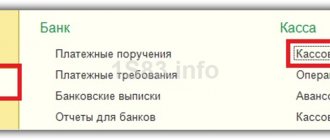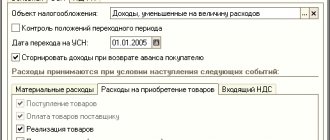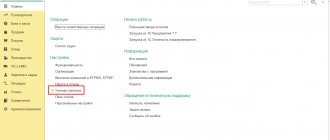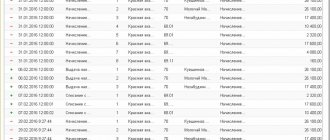Such expenses include, in particular:
- penalties for taxes and contributions to state extra-budgetary funds;
- contributions to some reserves;
- VAT amounts on excess expenses (Article 170 of the Tax Code of the Russian Federation);
- contributions to non-state pension funds (except for those listed in Article 255 of the Tax Code of the Russian Federation);
- contributions for some types of voluntary insurance (except for those mentioned in Articles 255, 263 and 291 of the Tax Code of the Russian Federation);
- the cost of gratuitously transferred property (work, services) and expenses associated with this transfer;
- any payments and rewards in favor of employees not provided for in labor or collective agreements, as well as financial assistance;
- negative differences from the revaluation of securities at market value;
- part of the costs of training, for example, the company’s payment for entertainment and recreation for student employees;
- depreciation on fixed assets that are not involved in income-generating production.
Let's consider the procedure for accounting for permanent positive differences in connection with the reflection of certain types of expenses in accounting.
Tax classification of expenses
Income and expenses are included in the calculation of income tax.
The accuracy of the final amount of tax liability for this tax depends on the correct classification of income and expenses for income tax. There are several tax classifications of expenses for the purpose of calculating income tax. Let's list the main ones. Expenses are divided into:
- for those related to production and sales and non-sales (clause 2 of Article 252 of the Tax Code of the Russian Federation);
- accepted when calculating income tax and not accepted (clause 1, article 252, article 270 of the Tax Code of the Russian Federation).
The main groups of costs associated with production and sales are shown in the figure:
Income from sales, in turn, is grouped into direct and indirect (Clause 1, Article 318 of the Tax Code of the Russian Federation). This division is extremely important for income tax purposes. Namely:
- direct income tax expenses must be distributed between the balances of work in progress, sold and unsold products;
- indirect income tax expenses can be fully taken into account in tax calculations in the reporting period without any distribution.
The group of non-operating expenses for income tax includes reasonable expenses not directly related to the production and (or) sale of goods (work, services). These include the costs of maintaining leased objects, paying interest on debt obligations, and others. Their list is not closed, which means the following: the law allows any justified costs to be recognized as non-operating expenses (clause 20 of Article 265 of the Tax Code of the Russian Federation).
For the nuances of recognizing shortages as non-operating expenses, see the article “Negligence by a warehouse manager is not a reason to consider shortages as non-operating expenses.”
Expenses may be included in the income tax base or may be excluded from it. This applies equally to any expenses incurred, regardless of their purpose. We will explain below how to correctly draw the line between unrecognized and expenses taken into account when calculating income tax.
How does gratuitously transferred property affect the formation of income tax?
To recognize the validity of certain expenses, they must meet the criteria established by Art. 252 of the Tax Code of the Russian Federation. All expenses incurred must have documentary evidence and also be economically justified, i.e. their goal is to obtain certain benefits.
The gratuitous transfer of property, i.e. the transfer of ownership without subsequent remuneration, excludes the receipt of economic benefits. Therefore, paragraph 16 of Art. 270 of the Tax Code of the Russian Federation prohibits taking into account in expenses the cost of gratuitously transferred property (work, services, property rights), as well as expenses associated with such transfer.
If the transferred property is depreciable, then certain nuances should be taken into account. Until the beginning of 2021, the provisions of paragraph 3 of Art. 256 of the Tax Code of the Russian Federation stated that depreciation is not charged on fixed assets that are transferred with the conclusion of an agreement on free use. It was possible to resume its accrual after the expiration of the contract and the return of the objects to the organization.
But from 01/01/2020, clause 16.7 of Art. 270 of the Tax Code of the Russian Federation prohibits the calculation of depreciation on objects returned after the expiration of the agreement on gratuitous use. This is due to the fact that mention of fixed assets transferred under contracts for free use is also excluded from clause 7 of Art. 259.1 of the Tax Code of the Russian Federation, which established the procedure for resuming depreciation upon termination of a contract of gratuitous use and the return of depreciable property to the taxpayer.
Such rules do not apply to property transferred for free use to government bodies and government agencies, if this obligation of the taxpayer is confirmed by law.
Which expenses reduce income tax and which do not?
Expenses in the income tax return are the amounts of costs that, in the taxpayer’s opinion, legally reduce the tax base, that is, comply with the requirements of tax legislation. These requirements are quite strict, and inspectors cling to literally every little detail: the expense is not economically justified, is not aimed at generating income, there are shortcomings in its documentary evidence, etc. Tax authorities are also trying to exclude expenses from the tax base due to their irrationality, ineffectiveness or inexpediency, although the Ministry of Finance does not support them in this (letter dated 04/19/2019 No. 03-03-07/28232).
Thus, any expense, after being examined by controllers, can instantly move from the group of recognized to the category of unrecognized tax expenses. In paragraph 49 of Art. 270 of the Tax Code of the Russian Federation directly states that when determining the tax base, expenses that do not meet the legally established criteria are not taken into account. The remaining 48 positions of this article contain specific types of expenses not recognized for income tax purposes - for charity, payment of dividends, fines and other sanctions transferred to the budget or extra-budgetary funds, payment of other similar obligations and expenses. All these expenses can be made exclusively from net profit.
Some expenses are included in tax calculations only occasionally (for example, VAT). The other part is recognized when calculating income tax according to the norms strictly established in the code, that is, not always in the full amount (read more about this below).
Can the costs of purchasing equipment be classified as expenses?
Equipment purchased by an organization should be classified as a receipt of fixed assets if this property meets the following requirements:
- intended for long-term use (more than 12 months);
- operation of the equipment is aimed at generating profit for the enterprise;
- subsequent resale of the object is not expected;
- the cost of the acquired property is not less than RUB 100,000.
Fixed assets are classified as depreciable assets. Acquisition costs are written off over the entire period of use, gradually reducing the taxable profit base.
Initial costs for the purchase (creation, modernization, reconstruction) of equipment, which is classified in accounting as a fixed asset, do not reduce the tax base (clause 5 of Article 270 of the Tax Code of the Russian Federation). The same provision also applies to lessees. Their expenses in the form of repurchase of the subject of the leasing agreement are considered as expenses for the acquisition of depreciable property.
Received equipment costing less than RUB 100,000. can be taken into account in costs when determining the taxable base at a time.
From 01.01.2018 to 31.12.2027, clause 5.1 of art. 270 of the Tax Code of the Russian Federation also prohibits taking into account for profit expenses for the acquisition, creation, completion, additional equipment, reconstruction, modernization, technical re-equipment of fixed assets in respect of which the taxpayer exercised the right to apply an investment tax deduction.
Under what circumstances is VAT taken into account as an expense?
Value added tax (VAT) is an independent tax liability. In most cases, VAT is not included in income tax expenses (Clause 19, Article 270 of the Tax Code of the Russian Federation).
However, under certain circumstances, the law allows the amount of this tax to be included in costs:
There is another situation when VAT is included in expenses: it was accrued, but was not presented to the buyer. Then the income tax base for such VAT will be reduced as part of other expenses (subclause 1, clause 1, article 264 of the Tax Code of the Russian Federation). The Ministry of Finance does not object to this approach (letter dated January 20, 2017 No. 03-03-06/1/3257).
Do voluntary insurance premiums reduce profits?
Expenses incurred under VHI agreements can reduce taxable profit. The classification of these expenses is given in Art. 255, 263 and 291 of the Tax Code of the Russian Federation. Other voluntary insurance costs do not affect the calculation. This is stated in paragraph 6 of Art. 270 Tax Code of the Russian Federation. Such expenses include voluntary liability insurance, which is not a condition of international standards for the activities of the entity. Thus, the insurance premiums that an organization is forced to pay in connection with a violation of a civil liability contract do not reduce profits. Such costs are also not included in the closed list of expenses in accordance with Art. 255, 263, 291 Tax Code of the Russian Federation.
The following voluntary insurance expenses can be taken into account when reducing taxable profit:
- contributions to the Pension Fund under voluntary insurance contracts for their employees;
- insurance of transport, cargo, goods and materials, and other property used in the course of business activities;
- insurance of certain types of risks and liability of organizations;
- life and health insurance of bank borrowers.
What expenses need to be normalized?
In tax legislation there is a separate group of expenses that can be taken into account when calculating income tax, not always in full. These expenses are called standardized.
Standardized income tax expenses are presented in the figure:
The amount limit (standard and recognition conditions) is established for each type of regulated expense. Let's take a closer look at the most common ones.
Penalties
For non-payment or late payment of taxes and contributions to state extra-budgetary funds, firms pay fines and penalties. They reduce accounting profit but do not affect the amount of taxable profit.
EXAMPLE In January of the reporting year, there were no differences in the accounting and tax records of Aktiv CJSC until the end of the month.
In both cases, income amounted to 800,000 rubles, and expenses - 500,000 rubles. On January 31, Aktiv paid penalties for late payment of taxes for last year in the amount of 850 rubles. In addition, one of the employees was accrued financial assistance in the amount of 10,000 rubles. The following entries were made in the accounting: DEBIT 90-9 CREDIT 99
– 300,000 rubles.
(RUB 800,000 – RUB 500,000) – reflects the company’s profit from its core activities; DEBIT 99 CREDIT 68 subaccount “Settlements of penalties”
– 850 rubles.
– penalties were charged for late taxes; DEBIT 68 subaccount “Settlements of penalties” CREDIT 51
– 850 rub.
– penalties have been paid; DEBIT 91-2 CREDIT 70
– 10,000 rub.
– financial assistance has been accrued to the employee; DEBIT 99 CREDIT 91-9
– 10,000 rub.
– loss is reflected.
Total profit for January was:
- in accounting – 289,150 rubles. (800,000 rub. – 500,000 rub. – 850 rub. – 10,000 rub.);
- in tax accounting – 300,000 rubles. (RUB 800,000 – RUB 500,000).
Thus, the constant difference in expenses is 10,850 rubles. (RUB 300,000 – RUB 289,150).
A conditional tax expense in the amount of RUB 57,830 was accrued from the accounting profit. (RUB 289,150 ×20%).
An entry was made in the accounting for the additional accrual of income tax:
DEBIT 99 subaccount “Permanent tax liability” CREDIT 68 subaccount “Calculations for income tax”
– 2170 rub.
(RUB 10,850 ×20%) – a permanent tax liability is reflected.
Thus, after adjustment according to PBU 18/02, the balance in account 68 of the subaccount “Calculations for income tax” amounted to 60,000 rubles. (57,830 rubles + + 2170 rubles) and equaled the amount of tax in the declaration.
Entertainment expenses
Income tax on entertainment expenses is reduced based on the following norm:
Subscribe to our newsletter
Yandex.Zen VKontakte Telegram
A specific list of such expenses is not established in the Tax Code of the Russian Federation. The Ministry of Finance of Russia, in letter No. 03-03-06/1/3120 dated January 22, 2019, clarified that the amount of entertainment expenses may include both food for organizing breakfasts, lunches and other similar events, and alcoholic beverages. The main condition: expenses must be supported by documents and economically justified.
To protect yourself from claims from tax authorities, write down the cost norms for alcohol in your internal local act. Then inspectors will have no reason to find fault with excessive volumes of purchased alcohol or the purchase of expensive vintage wine for meetings with partners.
But what about Article 54 of the Tax Code of the Russian Federation?
At the same time, there is Article 54 of the Tax Code of the Russian Federation, which is applied in a situation where a company made an error/distortion in calculating the tax base, and this error relates to the previous period. It is this item, according to some accountants, that allows you to “play” with expenses beyond one calendar year. Is this really true?
Based on this article, as a general rule, if an error is discovered, it is necessary to recalculate the tax base and, accordingly, the tax itself in the period in which the error was made (clause 1 of Article 54 of the Tax Code of the Russian Federation). It was admitted, not revealed.
However, there are exceptions to this rule (paragraph 3, paragraph 1, article 54 of the Tax Code of the Russian Federation). In two cases, it is allowed to make adjustments in the current period (during the period when errors/distortions are identified), which will allow you to avoid having to draw up an updated declaration:
- when it is impossible to understand which period the error/distortion belongs to;
- when an error/distortion resulted in excessive payment of tax.
We are interested in the second case – when, due to an error, the organization overpaid the tax. Therefore, if we assume that the “non-accounting” of any expenses last year was caused by an error and because of this “error” the company overpaid the tax, then it can take these expenses into account in the current period.
Thus, the norm seems to be working and, indeed, at first glance, allows companies to take into account expenses whenever they wish (taking into account a three-year period). However, as practice shows, not everything is so smooth. Companies in such situations may face difficulties during tax audits.
Advertising expenses
Advertising can be distributed in different ways: through radio announcements or broadcasting a commercial on television (using the media), placed on advertising stands or various types of transport.
Not all types of advertising expenses are standardized. Some of them can be recognized when calculating income tax in full, and some - according to a special standard, calculating them based on the revenue received in the reporting period:
Tax authorities do not always agree with taxpayers regarding the inclusion of advertising expenses in income tax expenses in full (without standardization). Disagreements are caused by unclear wording of the legislation, which does not detail certain nuances important for taxation. Then taxpayers are forced to defend their position in court.
For example, in the ruling of the Supreme Court of the Russian Federation dated May 30, 2019 No. 305-ES19-4394, the judges did not agree with the tax authorities that advertising on transport should be regulated. Among the reasons for such conclusions, the judges named the lack of legislation:
- definitions of outdoor advertising, which can be used as a guide when calculating income tax;
- the impact on tax calculations of the nuances of advertising distribution on stationary structures and vehicles.
The following articles will tell you how legislators limit the spread of certain types of advertising:
- “Advertising of custom-made diplomas has been outlawed”;
- “For the word “loan” in advertising, an organization faces a fine of up to 500,000 rubles.”
Production costs
So, classification group I of costs is expenses for core activities. These include the following:
- Material costs. These are expenses for the purchase of all types of raw materials, materials, components, equipment, works and services of a production nature, etc.
The features and nuances of accounting for these expenses are described in detail in this article .
- Labor costs. And this is not only salary, but a much wider range of accruals in favor of employees: bonuses, various additional payments and compensations, payment based on average earnings for legally unworked periods, dismissal, etc.
article is devoted to general issues of “salary” expenses .
Our other materials will help you correctly account for your expenses:
- bonuses;
For accounting nuances, see here and here ;
- vacation pay;
We wrote about them here .
- salary supplements;
this publication about them .
- and other expenses.
- Amounts of accrued depreciation. Our articles will help you decide on its method and correctly calculate the amounts:
- “What method to choose for calculating depreciation in tax accounting?”;
- “Linear method of calculating depreciation of fixed assets (example, formula)”;
- “A practical example of using the non-linear depreciation method”;
- “The essence and features of the application of the accelerated depreciation method.”
- Other expenses. These are all other expenses in addition to those listed above. For example, for rent, business trips, etc.
Find the main issues of their accounting in this article .
Expenses in the form of bad debt transferred under an assignment agreement
Almost every taxpayer faces the problem of writing off bad debts.
In one of the disputes, the company wrote off an uncollectible receivable that had previously been transferred under an assignment agreement.
But the receivable written off by the company was transferred under an assignment agreement, which was concluded after the liquidation of the debtor, and therefore the right of claim subject to assignment ceased before it was transferred to the taxpayer. Considering that the company is not a party to the supply agreement under which the debt arose, the judges came to the conclusion that the company has no grounds for writing off this debt ( Determination of the Supreme Court of the Russian Federation dated July 3, 2019 No. 306-ES19-10383 ).
Methods for recognizing expenses in NU
It is important not only to correctly classify expenses, but also to determine the correct date for their inclusion in the tax base. And this date depends on which method of accounting for income and expenses you have chosen. There are 2 such methods:
- accrual method, when expenses are recognized in the period in which they are incurred, regardless of the payment period;
- cash method - based on payment.
Each of them has its own characteristics, advantages and disadvantages. In addition, there is a very clear limitation on the use of the cash method of recognizing income and expenses.
The following articles in this section will help you choose the optimal method:
- “Accrual method and cash method: main differences”;
- “What is the procedure (conditions) for recognizing income and expenses using the cash method?”.
These articles are just a small part of what is presented in this subsection of our website. It is constantly updated with new relevant and useful materials. Visit it often and you will know everything about expense accounting.
Procedure for accounting for past expenses
Reflection of adjustments in accounting must be made last year, if the reporting has not yet been approved. In situations with approved forms of accounting reports, changes are made in the current reporting period. If expenses are discovered that were not shown in accounting and occurred in the past, postings D91.2 (84) and K60 (76) are made.
The company determines which debit account to use independently, based on the criterion of the materiality of the error. The degree of significance of inaccuracies in accounting is assessed according to the standards reflected in the accounting policies of the organization. For minor errors, it is recommended to use account 91; for significant amounts of unaccounted expenses, account 84 is used. When significant errors are identified, reporting indicators must be recalculated retrospectively.









